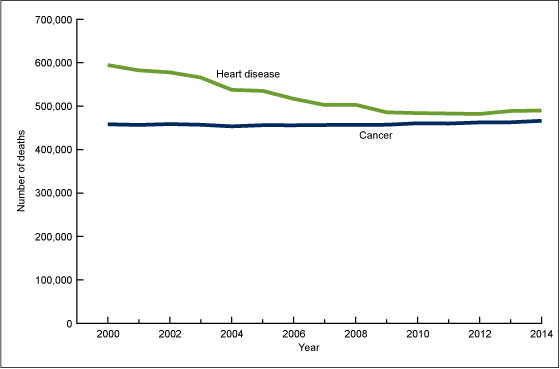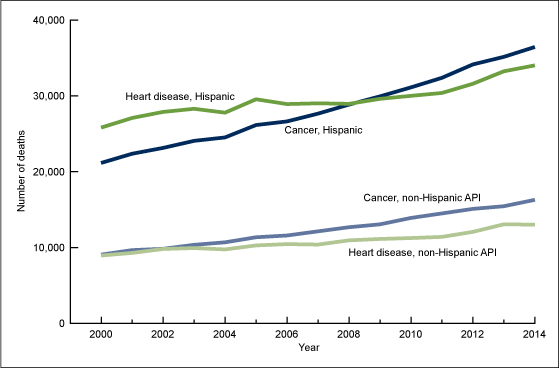Changes in the Leading Cause of Death: Recent Patterns in Heart Disease and Cancer Mortality
On This Page
- Key findings
- How has the mortality burden of heart disease and cancer changed from 1950 through 2014?
- Are there differences by state in the leading cause of death, and how have patterns changed from 2000 through 2014?
- How has the mortality burden of heart disease and cancer changed for the non-Hispanic white population from 2000 through 2014?
- How has the mortality burden of heart disease and cancer changed for the non-Hispanic black population from 2000 through 2014?
- How has the mortality burden of heart disease and cancer changed for the non-Hispanic Asian or Pacific Islander (API) and Hispanic populations from 2000 through 2014?
- Summary
- Data source and methods
- About the authors
- References
- Suggested citation
NCHS Data Brief No. 254, August 2016
PDF Version (473 KB)
Melonie Heron, Ph.D. and Robert N. Anderson, Ph.D.
Key findings
Data from the National Vital Statistics System
- Heart disease has consistently been the leading cause of death in the United States and remained so in 2014.
- The gap between the number of heart disease and cancer deaths generally widened from 1950 through 1968, narrowed from 1968 through 2012, and then slightly widened again from 2012 through 2014.
- The mortality burden of cancer has surpassed that of heart disease in several states. In 2000, there were only 2 states where cancer was the leading cause of death; in 2014, there were 22.
- Heart disease remained the leading cause of death for the non-Hispanic white and non-Hispanic black populations in 2014.
- Cancer is now the leading cause of death for the non-Hispanic Asian or Pacific Islander and Hispanic populations. The timing of the leading-cause crossover varied by group.
For the total U.S. population, heart disease has been the leading cause of death for decades, with cancer the second leading cause (1). However, the ranking of these causes has varied across demographic group and geographic unit over time. Rankings are based on the number of deaths and reflect mortality burden rather than risk of death (2). This report highlights changes in the mortality burden of heart disease and cancer and presents findings by state, race, and Hispanic origin.
Keywords: state, race, ethnicity, National Vital Statistics System
How has the mortality burden of heart disease and cancer changed from 1950 through 2014?
- The number of deaths due to heart disease has consistently been higher than the number of deaths due to cancer (Figure 1).
- The number of heart disease deaths decreased from a peak of 771,169 in 1985 to 596,577 in 2011, whereas the number of cancer deaths nearly tripled from 210,733 in 1950 to 576,691 in 2011.
- The number of deaths due to heart disease increased by 3.0% during the 2011–2014 period, from 596,577 to 614,348. Cancer deaths increased by 2.6% during the same period, from 576,691 to 591,699.
- The closing gap between heart disease and cancer suggested that a leading-cause crossover was likely in the early 2010s, but the reversal in trend for heart disease deaths in 2012 has kept heart disease just ahead of cancer in the rankings.
Figure 1. Number of deaths due to heart disease and cancer: United States, 1950–2014
NOTES: Leading cause is based on number of deaths. Access data table for Figure 1.
SOURCE: NCHS, National Vital Statistics System, Mortality.
Are there differences by state in the leading cause of death, and how have patterns changed from 2000 through 2014?
- Heart disease was the leading cause of death for all of the United States until 1990, when cancer became the leading cause of death for Alaska (data not shown).
- As of 2000, Alaska and Minnesota were the only two states where cancer was the leading cause of death (Figure 2).
- From 2000 through 2014, the cancer mortality burden surpassed that of heart disease in several other states. As of 2014, cancer was the leading cause of death in 22 states.
Figure 2. Leading cause of death for each state: United States, 2000 and 2014
NOTE: Leading cause is based on number of deaths.
SOURCE: NCHS, National Vital Statistics System, Mortality.
How has the mortality burden of heart disease and cancer changed for the non-Hispanic white population from 2000 through 2014?
- For the non-Hispanic white population, heart disease has been and remains the leading cause of death, with cancer the second leading cause (Figure 3).
- Since 2000, heart disease deaths generally decreased while cancer deaths increased. However, in recent years, the trend in heart disease deaths has reversed, with deaths increasing by 1.6% from 2012 through 2014.
- The gap between heart disease and cancer deaths for the non-Hispanic white population decreased substantially, from 136,265 in 2000 to a low of 19,492 in 2012, but it increased in subsequent years.
Figure 3. Number of deaths due to heart disease and cancer for the non-Hispanic white population: United States, 2000–2014
NOTES: Leading cause is based on number of deaths. Access data table for Figure 3.
SOURCE: NCHS, National Vital Statistics System, Mortality.
How has the mortality burden of heart disease and cancer changed for the non-Hispanic black population from 2000 through 2014?
- For the non-Hispanic black population, heart disease and cancer have consistently been the first and second leading causes of death, respectively (Figure 4).
- The decreasing trend in heart disease deaths since 2000 reversed, with deaths increasing by 6.4% during 2011–2014.
- The gap between heart disease and cancer deaths for the non-Hispanic black population narrowed from 15,316 in 2000 to a low of 1,437 in 2011. During 2012–2014, the gap was two to three times larger than in 2011.
Figure 4. Number of deaths due to heart disease and cancer for the non-Hispanic black population: United States, 2000–2014
NOTES: Leading cause is based on number of deaths. Access data table for Figure 4.
SOURCE: NCHS, National Vital Statistics System, Mortality.
How has the mortality burden of heart disease and cancer changed for the non-Hispanic Asian or Pacific Islander (API) and Hispanic populations from 2000 through 2014?
- For the non-Hispanic API population, cancer became the leading cause of death in 2000 when the number of cancer deaths (9,069) surpassed heart disease deaths (8,949) (Figure 5).
- During 2000–2014, the number of cancer deaths for the non-Hispanic API population increased by 79.6% (from 9,069 to 16,292) compared with a 45.5% increase in heart disease deaths (from 8,949 to 13,021).
- For the Hispanic population, the number of cancer deaths increased by 72.2% during 2000–2014 (from 21,160 to 36,447), while the number of heart disease deaths increased by 31.8% (from 25,819 to 34,021).
- Cancer replaced heart disease as the leading cause of death for the Hispanic population in 2009, when the number of cancer deaths (29,935) surpassed heart disease deaths (29,611).
Figure 5. Number of deaths due to heart disease and cancer for the non-Hispanic Asian or Pacific Islander and Hispanic populations: United States, 2000–2014
NOTES: API is Asian or Pacific Islander. Deaths for the non-Hispanic API and Hispanic populations are underreported by 3% each; see “Data source and methods.” Leading cause is based on number of deaths. Access data table for Figure 5.
SOURCE: NCHS, National Vital Statistics System, Mortality.
Summary
This report presents recent changes in the mortality burden of heart disease and cancer. Since the early 1900s, heart disease has been the leading cause of death in the United States and cancer the second leading cause (1). The number of deaths due to both heart disease and cancer has increased since 1950, largely due to the aging of the U.S. population. However, in the 1980s, the number of deaths due to heart disease began to decline, whereas the number of deaths due to cancer continued to increase. The result has been a substantial decrease in the gap between the two causes. While a leading-cause crossover seemed likely in the early 2010s, a reversal in the trend in heart disease deaths in 2012 kept heart disease in the top spot in the rankings.
Although a change in the rankings has not occurred for the United States as a whole, the rankings have changed for many states. By 2014, cancer had replaced heart disease as the leading cause of death in 22 states. While the gap in mortality burden between heart disease and cancer narrowed substantially for the non-Hispanic white and black populations, heart disease remains the leading cause for these groups. However, cancer has replaced heart disease as the leading cause of death for the non-Hispanic API and Hispanic populations. The timing of the leading-cause crossover varied by population subgroup.
Data source and methods
Mortality data for 1950–2014 presented in this report are from the National Vital Statistics System (NVSS) (3). Data are examined by state, race, and Hispanic origin for only the 2000–2014 period. NVSS mortality data reflect information collected from all death certificates filed in the 50 states and the District of Columbia. Deaths are classified according to the International Statistical Classification of Diseases and Related Health Problems, Tenth Revision (ICD–10) (4). Heart disease deaths are classified to ICD–10 codes I00–I09, I11, I13, and I20–I51. Cancer deaths are classified to ICD–10 codes C00–C97. All mortality statistics are based on the underlying cause of death and are restricted to U.S. residents. Race and Hispanic origin are reported separately on the death certificate. Persons of Hispanic origin may be of any race. Recent research has shown that, in the 1999–2011 period, deaths for the non-Hispanic API and Hispanic populations were underreported by 3% for each group, whereas no underreporting (or overreporting) of deaths was observed for the non-Hispanic white and non-Hispanic black populations (5). It was assumed that the levels of racial and ethnic underreporting observed in 1999–2011 data also apply to 2012–2014 data. Racial and ethnic underreporting is not expected to vary by cause of death or greatly impact leading-cause rankings (2).
Cause-of-death rankings indicate the mortality burden of one cause relative to other rankable causes. Mortality burden is measured based on the number of deaths (2). It does not indicate cause-specific mortality risk as death rates do.
Specified changes in the number of deaths are statistically significant at p < 0.05. Tests of statistical significance are described elsewhere (6).
About the authors
Melonie Heron and Robert N. Anderson are with the National Center for Health Statistics, Division of Vital Statistics.
References
- National Center for Health Statistics. Leading causes of death, 1900–1998. 2000.
- Heron M. Deaths: Leading causes for 2014. National vital statistics reports; vol 65 no 5. Hyattsville, MD: National Center for Health Statistics. 2016.
- National Center for Health Statistics. National Vital Statistics System. Mortality multiple cause files.
- WHO. International statistical classification of diseases and related health problems, tenth revision (ICD–10). 2008 ed. Geneva, Switzerland. 2009.
- Arias E, Heron M, Hakes JK. The validity of race and Hispanic-origin reporting on death certificates in the United States: An update. Vital Health Stat 2(172). Hyattsville, MD: National Center for Health Statistics. 2016.
- Kochanek KD, Murphy SL, Xu JQ, Tejada-Vera B. Deaths: Final data for 2014. National vital statistics reports; vol 65 no 4. Hyattsville, MD: National Center for Health Statistics. 2016.
Suggested citation
Heron M, Anderson RN. Changes in the leading cause of death: Recent patterns in heart disease and cancer mortality. NCHS data brief, no 254. Hyattsville, MD: National Center for Health Statistics. 2016.
Copyright information
All material appearing in this report is in the public domain and may be reproduced or copied without permission; citation as to source, however, is appreciated.
National Center for Health Statistics
Charles J. Rothwell, M.S., M.B.A., Director
Jennifer H. Madans, Ph.D., Associate Director for Science
Division of Vital Statistics
Delton Atkinson, M.P.H., M.P.H., P.M.P., Director
Hanyu Ni, Ph.D., M.P.H., Associate Director for Science
- Page last reviewed: August 24, 2016
- Page last updated: August 24, 2016
- Content source:


 ShareCompartir
ShareCompartir




